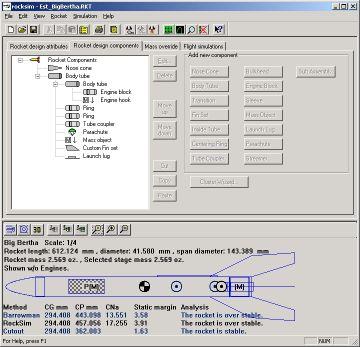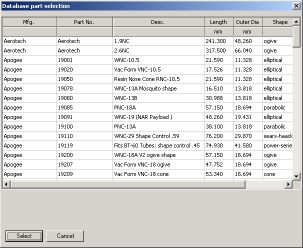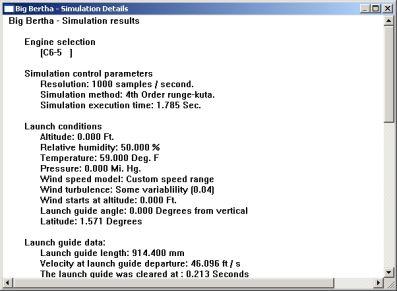Apogee Components RockSim (7.x) Design Software
Apogee Components - RockSim (7.x) Design Software {Software}
Contributed by Joe Policy
| Manufacturer: | Apogee Components  |
Description:
I purchased my copy of RockSim directly from the Apogee Rockets website over a year ago. The cost was only $95.00. I selected the immediate download option versus waiting for a CD to be mailed to me. When you make the purchase, you will receive an authorization to download the software from Apogee using a one time only login and password. I had no problems downloading the approximately 30MB file from the web site.
There have been several updates to the software, the latest version as of this writing is 7.04. I installed RockSim on a computer with Windows XP, but I understand it will work with a variety of operating systems from Windows 98 on up. It is not currently compatible with Apple MacIntosh® computers but the Apogee website says a Mac version is in the works.
 The RockSim software interface is easy to use and gives you enormous power over the customization of the software and of your rocket designs. I initially purchased RockSim to help me design scratch builds, but I have also used it to test a variety of kits that are commercially available. RockSim comes with a variety of .rkt files (the standard RockSim design file format) and there are many more to be found on the internet, the best source being right here on EMRR. I currently have over 1500 design files in my designs database. Recently, I have been concentrating on adding rockets that have reviews in EMRR but no RockSim files. It takes me about 20-40 minutes (depending on complexity) to measure the various components of a kit and enter the data into the RockSim interface. You can even add color to each component for a more realistic looking rocket!
The RockSim software interface is easy to use and gives you enormous power over the customization of the software and of your rocket designs. I initially purchased RockSim to help me design scratch builds, but I have also used it to test a variety of kits that are commercially available. RockSim comes with a variety of .rkt files (the standard RockSim design file format) and there are many more to be found on the internet, the best source being right here on EMRR. I currently have over 1500 design files in my designs database. Recently, I have been concentrating on adding rockets that have reviews in EMRR but no RockSim files. It takes me about 20-40 minutes (depending on complexity) to measure the various components of a kit and enter the data into the RockSim interface. You can even add color to each component for a more realistic looking rocket!
 The RockSim component database includes a variety of parts (nose cones, body tubes, transitions, etc.) from various manufacturers like Estes, Quest and PML. The database is easily updated so you can add your own custom components. For instance, I have most of the FlisKits components entered into my database. You start building your rocket from the top, usually starting with the nose cone. As you add components, you can see your rocket take shape in the 2D side view at the bottom of the screen. This screen gives you a variety of information about your design as you build it, including length, width, mass, CP, and CG locations and will even tell you if your design is stable or unstable based on Barrowman, Rocksim, or cardboard cutout methods. If you are designing a multi-stage rocket, you can view just the booster, just the sustainer or the whole enchilada. Other views include 2D base view (great for lining up fins and launch lugs) and a 3D view that lets you look at your design in full color and from any angle. New with version 7.04 is the ability to add decals to your design. I have not yet tested this feature, but it looks way cool and I cannot wait to try it.
The RockSim component database includes a variety of parts (nose cones, body tubes, transitions, etc.) from various manufacturers like Estes, Quest and PML. The database is easily updated so you can add your own custom components. For instance, I have most of the FlisKits components entered into my database. You start building your rocket from the top, usually starting with the nose cone. As you add components, you can see your rocket take shape in the 2D side view at the bottom of the screen. This screen gives you a variety of information about your design as you build it, including length, width, mass, CP, and CG locations and will even tell you if your design is stable or unstable based on Barrowman, Rocksim, or cardboard cutout methods. If you are designing a multi-stage rocket, you can view just the booster, just the sustainer or the whole enchilada. Other views include 2D base view (great for lining up fins and launch lugs) and a 3D view that lets you look at your design in full color and from any angle. New with version 7.04 is the ability to add decals to your design. I have not yet tested this feature, but it looks way cool and I cannot wait to try it.
 Once you have your design, it is time to test it. This is where I think RockSim really rocks. You pick the engines and delay times from the included engine database (and yes, this database is also customizable), select conditions such as temperature, wind direction and speed, launch pad angle, etc. and then go for launch. RockSim starts its calculations and when done, it will gives a summary view that will tell you how high your design would fly, max velocity, time to apogee, and will even suggest the best delay time for that perfect recovery system deployment. It will also let you know if your parachute deployed before or after apogee. You can bring up a details screen for even more information regarding your simulated launch. One thing it won't tell you is if your rocket got hung in a tree or power line--there are just some things even RockSim cannot predict!
Once you have your design, it is time to test it. This is where I think RockSim really rocks. You pick the engines and delay times from the included engine database (and yes, this database is also customizable), select conditions such as temperature, wind direction and speed, launch pad angle, etc. and then go for launch. RockSim starts its calculations and when done, it will gives a summary view that will tell you how high your design would fly, max velocity, time to apogee, and will even suggest the best delay time for that perfect recovery system deployment. It will also let you know if your parachute deployed before or after apogee. You can bring up a details screen for even more information regarding your simulated launch. One thing it won't tell you is if your rocket got hung in a tree or power line--there are just some things even RockSim cannot predict!
Not only do you get a summary of your flight, but you also get a 2D flight profile display which gives you simplified representation of your rocket launch with a slider co
 |
 |
D.L.B. (June 14, 2004)
D.B. (August 5, 2008)
Dave Stout (January 2, 2014)
I received some kits from Apogee for Christmas, and included with them was an offer for a free trial version of Rocksim. I was pretty impressed with the kits, so I figured, Why not try the vaunted Rocksim? So I downloaded the trial version. It was slow to load, despite being a relatively small file. It takes an eternity to set up a rocket simulation. I found the setup process to be overly detailed and confusing. The information garnered was of limited use. This program just doesn't provide enough usable information to be worth the bother, in my opinion. I ran a couple of simulations and was already bored and wanting to move on before the simulations were fully prepared. After trying the program, I purged it from my computer the same day. I'll stick to Stine's Handbook of Model Rocketry when I design new rockets. For over a hundred dollars, there is no way I'd even remotely consider buying this program.
 |
 |
G.P. (June 2, 2004)